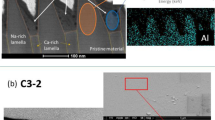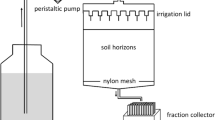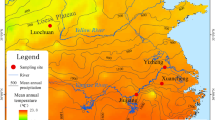Abstract
Many natural catchments are now under threat of acidification from natural and anthropogenic sources. Acids introduced to the catchments are neutralized by reaction with soil constituents (including clay minerals and feldspars) and a better understanding of the mechanisms of neutralization is required to evaluate effects of acid deposition in sensitive catchments. The response of feldspars to these acids has been generally studied by monitoring the composition of the weathering solutions. The dissolution of albite and perthite is initially incongruent, with Na- and K-depleted residues produced at the expense of the feldspars1–4. Such residues can be detected by secondary ion mass spectrometry using the specimen isolation technique provided the residues are greater than ˜40 Å thick. Here we report secondary ion mass spectrometric studies of naturally weathered feldspar surfaces. The acidic soil waters of many catchments have high contents of total dissolved aluminium5–10, including some from the Plastic Lake Catchment in Ontario, and we consider the effects of feldspar dissolution on Al contents of acidic soil waters.
This is a preview of subscription content, access via your institution
Access options
Subscribe to this journal
Receive 51 print issues and online access
$199.00 per year
only $3.90 per issue
Buy this article
- Purchase on Springer Link
- Instant access to full article PDF
Prices may be subject to local taxes which are calculated during checkout
Similar content being viewed by others
References
Chou, L. & Wollast, R. Geochim. cosmochim. Acta 48, 2205–2217 (1984).
Chou, L. & Wollast, R. Am. J. Sci. 285, 963–993 (1985).
Holdren, G. R. & Speyer, P. M. Am. J. Sci. 285, 994–1026 (1985).
Holdren, G. R. & Speyer, P. M. Geochim. cosmochim. Acta 51, 2311–2318 (1987).
LaZerte, B. D. & Dillon, P. J. Can. J. Fish. aquat. Sci. 41, 1664–1677 (1984).
LaZerte, B. D. Can. J. Fish. aquat. Sci. 41, 766–776 (1984).
Hooper, R. P. & Shoemaker, C. A. Nature 229, 463–465 (1985).
Sullivan, T. J., Christophersen, N., Muniz, I. P., Seip, H. M. & Sullivan, P. D. Nature 323, 324–327 (1986).
Cronan, C. S., Walker, W. J. & Bloom, P. R. Nature 324, 140–143 (1986).
Nordstrom, D. K. & Ball, J. W. Science 232, 54–56 (1986).
Lovering, J. F. U.S. natn Bur. Stand., Spec. Publ. 427, 135–178 (1975).
Shimizu, N., Semet, M. P. & Allegre, C. J. Geochim. cosmochim. Acta 42, 1321–1334 (1978).
Liebl, H. Scanning 3, 79–89 (1980).
Reed, S. J. B. Scanning 3, 119–127 (1980).
Steele, I. M., Hervig, R. L., Hutcheon, I. D. & Smith, J. V. Am. Miner. 66, 526–546 (1981).
Shimizu, N. & Hart, S. R. A. Rev. Earth planet. Sci. 10, 483–526 (1982).
Hayward, P. J., Hocking, W. H., Doern, F. E. & Cecchetto, E. V. in Scientific Basis for Nuclear Waste Management (ed. Lutze, W. L.) 319–328 (North Holland, Amsterdam, 1982).
Bancroft, G. M., Metson, J. B., Kresovic, R. A. & Nesbitt, H. W. Geochim. cosmochim. Acta 51, 911–918 (1987).
Schott, J. & Petit, J. C. in Aquatic Surface Chemistry: New Evidence for the Mechanisms of Dissolution of Silicate Minerals (ed. Stumm, W.) 293–315 (Wiley, New York, 1987).
Metson, J. B., Bancroft, G. M., Mclntyre, N. S. & Chauvin, W. J. Surface Interface Anal. 5, 181–185 (1983).
Metson, J. B., Bancroft, G. M. & Nesbitt, H. W. Scanning Electron Microscopy 2, 595–603 (1985).
Havette, A. Scanning Electron Microscopy 2, 585–594 (1985).
Streit, L. A., Hervig, R. L. & Williams, P. in Microbeam Analysis: Quantitative SIMS Microanalysis of Trace Elements in Geological Samples using in situ Ion-implanted Standards (eds Romig, A. D. & Chambers, W. F.) 91–94 (San Francisco Press, 1986).
Helgeson, H. C. Geochim. cosmochim. Acta 35, 421–469 (1971).
Berner, R. A. & Holdren, G. R. Geology 5, 369–372 (1977).
Luce, R. W., Bartlett, R. W. & Parks, G. A. Geochim. cosmochim. Acta 36, 35–50 (1972).
Paces, T. Geochim. cosmochim. Acta 37, 2641–2663 (1973).
Author information
Authors and Affiliations
Rights and permissions
About this article
Cite this article
Nesbitt, H., Muir, I. SIMS depth profiles of weathered plagioclase and processes affecting dissolved Al and Si in some acidic soil solutions. Nature 334, 336–338 (1988). https://doi.org/10.1038/334336a0
Received:
Accepted:
Published:
Issue Date:
DOI: https://doi.org/10.1038/334336a0
This article is cited by
-
Formation of iron-containing colloids by the weathering of phyllite
Aquatic Geochemistry (2006)
-
The influence of natural mineral coatings on feldspar weathering
Nature (1998)
Comments
By submitting a comment you agree to abide by our Terms and Community Guidelines. If you find something abusive or that does not comply with our terms or guidelines please flag it as inappropriate.



